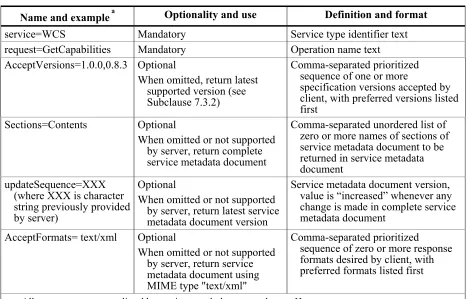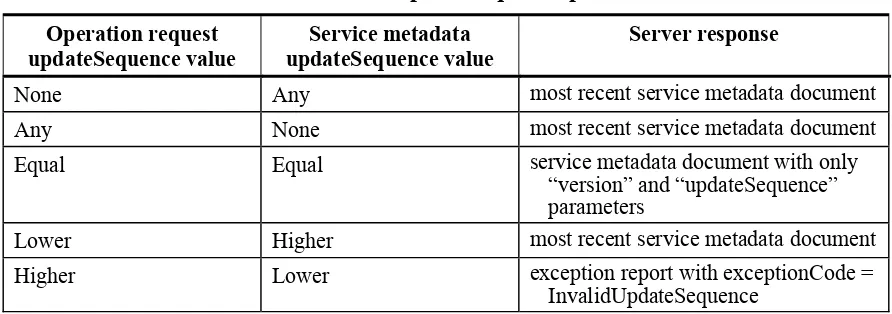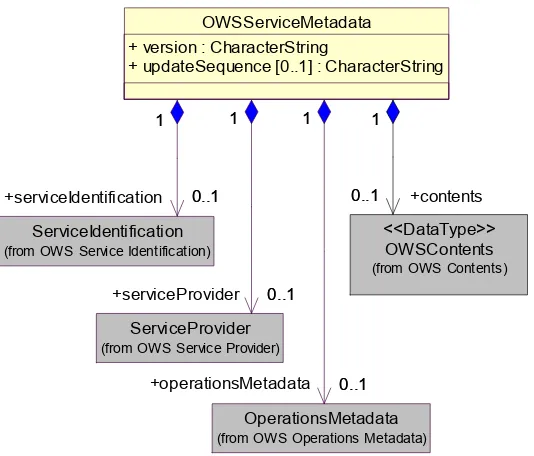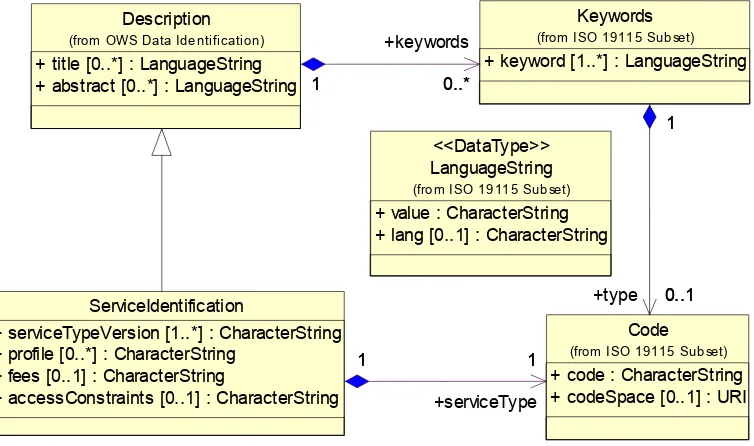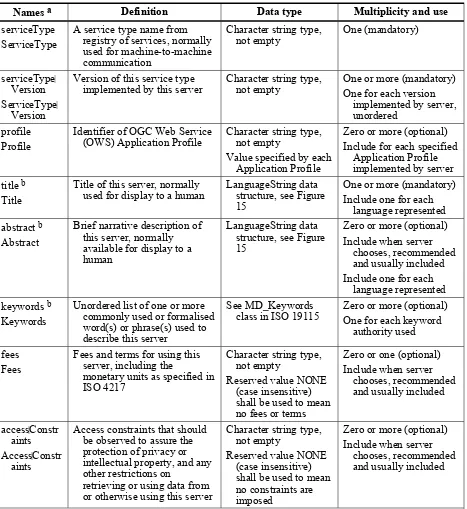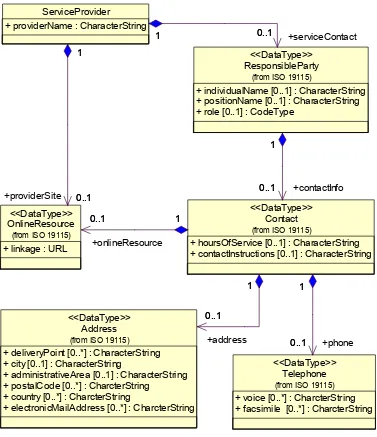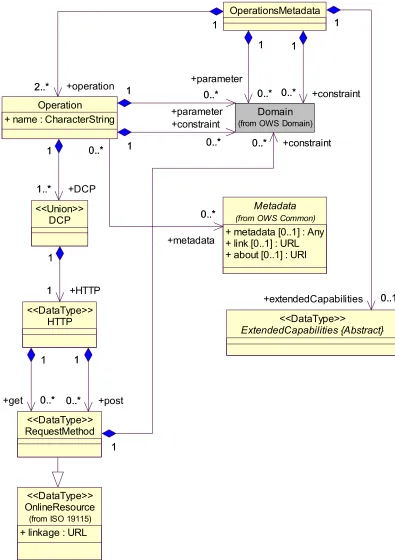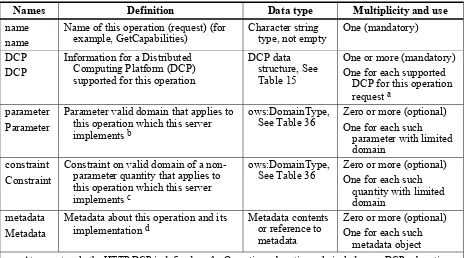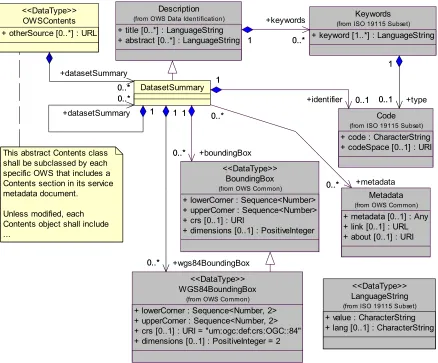Open Geospatial Consortium Inc.
Date:2007-02-09
Reference number of this document:OGC 06-121r3
Version:1.1.0 with Corrigendum 1
Category:OGC® Implementation Specification
Editor:Arliss Whiteside
OGC Web Services Common Specification
Copyright © 2006 Open Geospatial Consortium, Inc. All Rights Reserved.
To obtain additional rights of use, visit http://www.opengeospatial.org/legal/.
Recipients of this document are invited to submit, with their comments,
notifications of any revelant patent rights of which they are aware and to provide supporting documentation.
Document type: OpenGIS® Implementation Specification
Document subtype: Normatively referenced by other Implementation Specifications Document stage: Proposed Version 1.1.0
Contents
Pagei. Preface... ix
ii. Document terms and definitions ... ix
iii. Document contributor contact points...x
iv. Revision history ...x
v. Changes to the OGC Abstract Specification... xi
vi. Future work... xi
Foreword ... xiii
Introduction... xiv
1 Scope...1
2 Conformance...1
3 Normative references ...1
4 Terms and definitions ...3
5 Conventions ...5
5.1 Symbols (and abbreviated terms) ...5
5.2 UML notation ...6
5.3 Document terms and definitions...8
5.4 Platform-neutral and platform-specific specifications ...8
5.5 Data dictionary tables ...9
6 Document overview ...11
7 GetCapabilities operation...12
7.1 Introduction ...12
7.2 GetCapabilities request...13
7.2.1 GetCapabilities request parameters...13
7.2.2 Implementation requirements ...14
7.2.3 GetCapabilities request KVP encoding...15
7.2.4 GetCapabilities request XML encoding...16
7.3 Parameter discussions...19
7.3.1 Version parameter ...19
7.3.2 Version negotiation ...19
7.3.3 Sections parameter ...20
7.3.4 updateSequence parameter...21
7.3.5 AcceptFormats parameter ...21
7.4 GetCapabilities response ...22
7.4.1 Exceptions ...22
7.4.2 Service metadata document contents ...23
7.4.3 Implementation requirements ...25
7.4.4 ServiceIdentification section contents ...25
7.4.5 ServiceProvider section contents ...28
7.4.6 OperationsMetadata section contents...29
7.4.7 OperationsMetadata section standard contents ...33
7.4.8 Contents section contents...34
7.4.9 Capabilities document XML encoding ...39
7.4.10 Service metadata XML example...40
8 Exception reports ...42
8.1 Introduction ...42
8.2 Exception report contents ...43
8.3 exceptionCode parameter values...44
8.4 “locator” parameter values ...45
8.5 Exception report XML encoding...45
9 Other operations...46
9.1 Introduction ...46
9.2 All operations except GetCapabilities, minimum abilities...46
9.2.1 Operation request parameters...46
9.2.2 Operation request KVP encoding example ...46
9.2.3 Operation request XML encoding...47
9.3 Operation response ...47
9.4 GetResourceByID operation ...47
9.4.1 Introduction ...47
9.4.2 Operation request ...48
9.4.2.1 GetResourceByID request parameters...48
9.4.2.2 ResourceID values ...49
9.4.2.3 GetResourceByID request KVP encoding...50
9.4.2.4 GetResourceByID request XML encoding...51
9.4.3 Operation response...51
9.4.3.1 GetResourceByID normal response...51
9.4.3.2 Exceptions...51
9.4.4 Examples ...52
9.4.4.1 GetResourceByID request ...52
9.4.4.2 GetResourceByID response ...52
10 Other operation parameters...53
10.1 Introduction ...53
10.2 Bounding box ...54
10.2.1 General bounding box parameters ...54
10.2.2 WGS 84 bounding box parameters ...55
10.2.3 Bounding box KVP encoding ...56
10.2.4 Bounding box XML encoding ...58
10.2.5 Bounding box use...58
10.3 Coordinate reference system references ...59
10.3.1 Overview ...59
10.3.2 URL references ...60
10.3.3 URN references...61
10.4 Lists of references...61
10.5 Format parameters ...62
10.6 Data descriptions ...63
10.6.1 Basic metadata parameters...63
10.6.2 Mappings to common queryable and returnable properties...67
10.6.3 Basic set of description parameters...67
10.6.4 Brief set of data identification parameters ...69
10.6.5 Metadata parameter encoding ...71
10.6.6 XML examples...71
10.7 Multilingual text encoding ...72
10.7.1 Introduction ...72
10.7.2 UML model...72
10.7.3 Scoping rules...73
10.7.4 XML encoding ...73
11 Operation request and response encoding...74
11.1 General HTTP rules...74
11.2 HTTP GET ...74
11.3 Reserved and encoded characters in HTTP GET URLs ...75
11.4 HTTP POST ...76
11.5 KVP encoding ...76
11.5.1 Introduction ...76
11.5.2 Capitalization ...76
11.5.3 Parameter value lists ...77
11.5.4 Numeric and boolean values ...77
11.5.5 Parameter names ...77
11.6 XML encoding...78
11.6.1 Introduction ...78
11.6.2 Capitalization ...78
11.6.3 XML Schema documentation ...78
11.6.4 Namespaces...78
11.6.5 XML Schema extension and restriction...79
11.6.6 Application schemas ...79
11.7 HTTP responses...81
12 Guidance for OWS Implementation Specifications...82
12.1 General guidance ...82
12.2 XML Schema Document file names ...82
12.3 XML Schema Document file versions ...83
12.4 XML Schema Document locations ...83
12.5 Base URL references resource describing server ...83
12.6 Valid URLs in operation requests and responses ...85
12.7 Can define more XML global names ...86
13 Other data structures ...86
13.1 Introduction ...86
13.2 Domain ...87
13.2.1 Overview ...87
13.2.2 Domain data structure encoding...92
13.3 Manifest ...93
13.3.1 Introduction ...93
13.3.2 Manifest contents ...94
13.3.3 XML encoding ...98
13.3.4 Finding the manifest...99
13.4 OperationResponse...99
13.4.1 Introduction ...99
13.4.2 XML encoding ...101
13.5 InputData ...102
13.5.1 Introduction ...102
13.5.2 XML encoding ...105
Annex A (normative) Abstract test suite ...107
A.1 Introduction ...107
A.2 Specification test module ...108
A.3 Client test module...108
A.4 Server test module ...109
Annex B (normative) XML schema documents ...113
Annex C (informative) UML model ...115
C.1 Introduction ...115
C.2 OWS Get Capabilities package ...117
C.3 OWS Service Identification package...119
C.4 OWS Service Provider package ...120
C.5 OWS Operations Metadata package...121
C.6 OWS Contents package ...122
C.7 OWS Exception Report package ...123
C.8 OWS Get Resource By ID package...124
C.9 OWS Data Identification and Common packages...125
C.10 OWS Domain package ...127
C.11 Manifest package...128
C.12 OWS Input Output package...129
Annex D (informative) Reasons for parameters ...130
D.1 Introduction ...130
D.2 Reasons for GetCapabilities request parameters ...130
D.3 Reasons for service metadata sections ...132
D.4 Reasons for ServiceIdentification parameters ...132
D.5 Reasons for ServiceProvider parameters...134
D.6 Reasons for OperationsMetadata parameters ...136
D.7 Reasons for all operations except GetCapabilities minimum parameters ...138
D.8 Reasons for Exception Report parameters ...138
D.9 Use cases for Sections parameter ...139
D.10 Requirements for exception reports...139
D.11 Version negotiation backward compatibility...140
D.12 Bounding box requirements ...141
D.13 Minimum bounding boxes...142
D.14 CRS reference requirements...143
D.15 Reasons for data metadata parameters ...148
D.16 Reasons for DomainType data structure ...150
Bibliography 153
Figures
PageFigure 1 — UML notations 6
Figure 2 — GetCapabilities operation request UML class diagram 13
Figure 3 — GetCapabilities operation response UML class diagram 24
Figure 4 — ServiceIdentification section UML class diagram 26
Figure 5 — ServiceProvider section UML class diagram 28
Figure 6 — OperationsMetadata section UML class diagram 30
Figure 7 — Contents section UML class diagram 35
Figure 8 — Exception report UML class diagram 43
Figure 9 — Minimum operation request UML class diagram 46
Figure 10 — GetResourceByID request UML class diagram 48
Figure 11 — BoundingBox UML class diagram 54
Figure 12 — Basic metadata parameters UML class diagram 64
Figure 13 — Description UML class diagram 68
Figure 14 — Identification UML class diagram 69
Figure 15 — LanguageString UML class 73
Figure 16 — Domain UML class diagram 88
Figure 17 — Manifest package UML class diagram 94
Figure 18 — Input Output package partial UML class diagram 101
Figure 19 — Input Output package partial UML class diagram 103
Figure C.1 — OWS Common UML package diagram 116
Figure C.2 — OWS Get Capabilities UML package 118
Figure C.3 — OWS Service Identification UML package 119
Figure C.4 — OWS Service Provider UML package 120
Figure C.5 — OWS Operations Metadata UML package 121
Figure C.6 — OWS Contents UML package 122
Figure C.7 — OWS Exception Report UML package 123
Figure C.8 — OWS Get Resource By ID UML package 124
Figure C.9 — OWS Data Identification and Common UML packages 126
Figure C.10 — OWS Domain UML package 127
Figure C.11 — Manifest UML package 128
Figure C.12 — OWS Input Output UML package 129
Tables
PageTable 1 — Contents of data dictionary tables ... 10
Table 2 — Subjects discussed in this document... 11
Table 3 — Parameters in GetCapabilities operation request... 14
Table 4 — Implementation of parameters in GetCapabilities operation request ... 15
Table 5 — GetCapabilities operation request URL parameters ... 16
Table 6 — Meanings of section name values... 20
Table 7 Use of updateSequence parameter... 21
Table 8 — Exception codes for GetCapabilities operation ... 23
Table 9 — Parameters included in service metadata document ... 24
Table 10 — Section names and contents... 25
Table 11 — Parameters included in ServiceIdentification section... 27
Table 12 — Parameters included in ServiceProvider section ... 29
Table 13 — Parts of OperationsMetadata section ... 31
Table 14 — Parts of Operation data structure ... 32
Table 15 — Parts of DCP data structure ... 32
Table 16 — Parts of HTTP data structure ... 32
Table 17 — Parts of Request Method data structure... 33
Table 18 — Required values of OperationsMetadata section attributes ... 33
Table 19 — Optional values of OperationsMetadata section attributes ... 33
Table 20 — Parts of Contents section ... 35
Table 21 — Minimum parts of DatasetSummary data structure... 37
Table 22 — Inheritance of parts of DatasetSummary data structure... 38
Table 23 — Parameters in Exception element ... 43
Table 24 — Additional parameters in Exception Report ... 44
Table 25 — Standard exception codes and meanings ... 44
Table 26 — Parameters used by all operation requests except GetCapabilities... 46
Table 27 — Parameters in GetResourceByID operation request ... 49
Table 28 — GetResourceByID operation request URL parameters ... 50
Table 29 — GetResourceByID exception codes and meanings... 51
Table 30 — Parameters included in general BoundingBox data type... 55
Table 31 — Parameters included in WGS84BoundingBox data type... 56
Table 32 — Basic metadata parameters ... 65
Table 33 — Parameter mappings to common queryable and returnable properties... 67
Table 34 — Structure of operation request using HTTP GET ... 75
Table 35 — Reserved characters in operation request strings... 76
Table 36 — Parts of DomainType data structure ... 89
Table 37 — Parts of UnNamedDomainType data structure... 90
Table 38 — Parts of PossibleValues data structure... 90
Table 39 — Parts of ValuesUnit data structure ... 91
Table 40 — Parts of AllowedValues data structure ... 91
Table 41 — Parameters in Range data structure ... 91
Table 42 — Values of RangeClosure enumeration ... 92
Table 43 — Parameters in DomainMetadata data structure... 92
Table 44 — Parameters in ValuesReference data structure ... 92
Table 45 — Manifest data structure ... 95
Table 46 — ReferenceGroup data structure ... 96
Table 47 — ReferenceBase data structure ... 97
Table 48 — Reference data structure ... 98
Table 49 — ServiceReference data structure ... 104
Table D.1 — Reasons for GetCapabilities request parameters ... 131
Table D.2 — Reasons against GetCapabilities parameters ... 132
Table D.3 — Reasons for service metadata sections... 132
Table D.4 — Reasons for ServiceIdentification parameters ... 133
Table D.5 — Corresponding parameter names ... 134
Table D.6 — Reasons for ServiceProvider parameters and subsections... 134
Table D.7 — Corresponding parameter names ... 135
Table D.8 — Reasons for OperationsMetadata parameters and subsections ... 137
Table D.9 — Reasons for parameters in all operation requests except GetCapabilities ... 138
Table D.10 — Reasons for Exception Report parameters... 138
Table D.11 — Reasons against Exception Report parameters ... 138
Table D.12 — Reasons for data metadata parameters... 148
Table D.13 — Other data metadata parameters ... 150
i. Preface
This is Version 1.1 of the OGC Web Services Common Specification, which supersedes Version 1.0 [OGC 05-008]. This version contains the change requests documented in OGC 05-070r4, 06-015r3, 06-048, 06-056r1, 06-099, 06-100, 06-101, 06-117, 06-120r1, and 06-127r1.
This document specifies many of the aspects that are, or should be, common to all or multiple OGC Web Service (OWS) interface Implementation Specifications. These common aspects are primarily some of the parameters and data structures used in operation requests and responses. Of course, each such Implementation Specification must specify the additional aspects of that interface, including specifying all additional parameters and data structures needed in all operation requests and responses.
Each existing OGC-approved and draft OWS interface Implementation Specification should consider this document to be a formal change request to modify that specification in its next revision to agree with all the relevant material specified herein. Each such specification is also requested to normatively reference each relevant part of this document, instead of repeating the same material in each such Implementation
Specification. Such normative references can take the form of stating “This TBD shall include TBD as specified in Subclause TBD of OGC document TBD.” Such normative references are expected to:
a) Reduce the work needed to edit and read each such Implementation Specification b) Reduce the length of each such Implementation Specification
c) Increase interoperability among such Implementation Specifications by increasing commonality and discouraging non-essential differences
d) Reduce the work needed to program OWS clients and servers
To simplify preparation of new or revised Implementation Specifications that normatively reference this document, a template for such specifications has been
prepared, and use of this template is recommended. The current version of this template is document [OGC 05-009r2].
Suggested additions and improvements of this specification are welcome and encouraged. Such suggestions should be submitted as formal change requests, using the change
request template [OGC 06-112].
ii.
Document terms and definitions
This document uses the specification terms defined in Subclause 5.3, which is based on the ISO/IEC Directives, Part 2. Rules for the structure and drafting of International
Standards. In particular, the word “shall” (not “must”) is the verb form used to indicate a requirement to be strictly followed to conform to this specification.
iii.
Document contributor contact points
All questions regarding this document should be directed to the editor or the contributing members of the Revision Working Group:
Name Organization
Arliss Whiteside BAE Systems E&IS Steven Keens PCI Geomatics Stan Tillman Intergraph Rhonda Fetters Ionic John Herring Oracle
Peter Vretanos CubeWerx, Inc.
iv. Revision
history
Date Release Editor Primary clauses modified
Description
2003-10-06 0.0.0 Arliss Whiteside
All Initial version
2003-10-16 0.1.0 Arliss Whiteside
7.2.2.3, 7.4.3, 8.1 First approved discussion paper, small additions based on discussions in Architecture WG
2003-11-26 0.1.1 Arliss Whiteside
7.2.2, 7.2.3, 7.2.5, 8.1, 8.3, 11, A.2, A.4, B, C
Large additions to 7.2.5; significant editing of 7.4; addition of 11, B, and C; editing of most other parts
2003-12-22 0.1.2 Arliss Whiteside
6-11, A-C Document reorganized, edited most parts
2004-01-05 0.1.3 Arliss Whiteside
5.1, 7, A-C Document edited to correct errors and make clearer
2004-01-11 0.1.4 Arliss Whiteside
7.4, A-C Modify two sections of service metadata
2004-01-15 0.2.0 Arliss Whiteside
7.4.2, 7.4.5, cover, i Corrected Tables 7 and 13, edited to reflect approval as a Recommendation Paper 2004-03-05 0.2.1 Arliss
Whiteside
ii, 10, 11, B, C.12 to C.14
Added specifications of bounding boxes and CRS references, added more information on encoding, miscellaneous editing
2004-03-29 0.2.2 Arliss Whiteside
3, 4.1, 7.3.3, 7.3.5, 7.4.2, 7.4.6, 7.4.7, 11.3, A, C.11
A few small changes plus many wording improvements
2004-04-12 0.2.3 iii, 7.4.6, 7.4.7, 9.2.3, 11.3, A, C.6
Various small improvements, changed owsCommon/xsd to
owsGetCapabilities.xsd
Date Release Editor Primary clauses modified
Description
2004-06-17 0.3.1 Arliss Whiteside
10.3 In URNs, changed “ogc” to “opengis”
2004-12-17 0.3.2 Arliss Whiteside
i, 10.3, 10.6, B, C.15 Added material on data identifications, in URNs, changed “opengis” to “ogc”, updated UML model
2005-01-25 0.4.0 Arliss Whiteside
Cover, i Edited for approved Recommendation Paper
2005-05-03 1.0.0 Greg Buehler
Cover, I Edited for public release as Approved Implementation Specification 2005-05-23 05-008r1 Arliss
Whiteside
7.4.6, 7.4.7, 9.4, 9.5, 10.7, 11.5.5, 12.5, 12 6, A, B, C
Added draft extensions and improvements developed by the Harmonization WG
2006-09-11 1.1.0 Arliss Whiteside
i, 4, 5.4, 5.5, 7.4.7, 8.3, 9.4, 10.7, 12, 13, A, B, C, D.16
Included change requests OGC 05-070r4, 015r3, 048, 056r1, 099, 06-100, 06-101, 06-117, and 06-120r1 2006-09-18 1.1.0 Arliss
Whiteside
5.5, 7.2.2, 7.4.3, 7.4.4, 7.4.6, 7.4.7, 7.4.8, 9.4.2.2, 10.6.1, 10.6.4, 11.5.5, 13.3.2, C.0
Corrected typographical errors and improved wording
2006-10-19 1.1.0 Arliss Whiteside
I, 3, 7.4.4,7.4.8, 8.2, 10.2.1, 10.6.1, 10.6.2, 10.6.4, 10.6.5, 10.7, 13.3.2,13.4.1, 13.5.1, C.3, C.4, C.6 through C.12
Included change request 06-127r1 plus several UML corrections
v.
Changes to the OGC Abstract Specification
The OGC™ Abstract Specification does not require changes to accommodate the technical contents of this document.
vi. Future
work
This document should be extended to include other aspects that should be common among multiple OWS Implementation Specifications, such as:
a) Specify SOAP and WSDL encoding of operations
b) Improve organization of service metadata documents, such as to better match WSDL and UDDI
c) More of the contents of service metadata documents, such as for query language metadata
d) More common operations, such as for the Transaction operation e) Expansion to handle chained services
f) Better accommodate use of various human languages, where applicable in most operation requests and responses
g) Improve and expand Annex A abstract test suites
h) Resolve EDITOR’S QUESTIONS stated in Subclause 12.5 and elsewhere
Foreword
This revision of the OGC Web Services Common Specification supersedes and replaces OGC Implementation Specification 05-008.
This document includes four annexes; Annexes A and B are normative, and Annexes C and D are informative.
Attention is drawn to the possibility that some of the elements of this document may be the subject of patent rights. The Open Geospatial Consortium Inc. shall not be held responsible for identifying any or all such patent rights.
Introduction
This document specifies many of the aspects that are, or should be, common to all or multiple OWS interface Implementation Specifications. Those specifications currently include the Web Map Service (WMS), Web Feature Service (WFS), and Web Coverage Service (WCS). These common aspects include: operation request and response contents; parameters included in operation requests and responses; and encoding of operation requests and responses.
This revision is an expanded version of this document.
OGC Web Services Common Specification
1 Scope
This document specifies many of the aspects that are, or should be, common to all or multiple OWS interface Implementation Specifications. The common Implementation Specification aspects specified by this document currently include:
a) Operation request and response contents, most partial
b) Parameters and data structures included in operation requests and responses c) XML and KVP encoding of operation requests and responses
One use of this document is as a normative reference from future versions of OWS interface Implementation Specifications. Those specifications currently include the Web Map Service (WMS), Web Feature Service (WFS), and Web Coverage Service (WCS). Rather than continuing to repeat this material in each such Implementation Specification, each specification should normatively reference each relevant part of this document.
2 Conformance
Conformance with this specification shall be checked using all the relevant abstract tests specified in the Abstract Test Suite provided in Annex A of this specification. More specifically, all the relevant abstract tests in Annex A shall be included or referenced in the Abstract Test Suite in each separate specification that normatively references this specification.
3 Normative references
The following normative documents contain provisions which, through reference in this text, constitute provisions of this document. For dated references, subsequent
amendments to, or revisions of, any of these publications do not apply. For undated references, the latest edition of the normative document referred to applies.
CGI, The Common Gateway Interface, National Center for Supercomputing Applications,
http://hoohoo.ncsa.uiuc.edu/cgi/
IETF RFC 2045 (November 1996), Multipurpose Internet Mail Extensions (MIME) Part One: Format of Internet Message Bodies, Freed, N. and Borenstein N., eds.,
http://www.ietf.org/rfc/rfc2045.txt
IETF RFC 2141 (May 1997), URN Syntax, R. Moats, http://www.ietf.org/rfc/rfc2141.txt
IETF RFC 2396 (August 1998), Uniform Resource Identifiers (URI): Generic Syntax, Berners-Lee, T., Fielding, N., and Masinter, L., eds., http://www.ietf.org/rfc/rfc2396.txt
IETF RFC 2616 (June 1999), Hypertext Transfer Protocol – HTTP/1.1, Gettys, J., Mogul, J., Frystyk, H., Masinter, L., Leach, P., and Berners-Lee, T., eds.,
http://www.ietf.org/rfc/rfc2616.txt
IETF RFC 4646 (September 2006), Tags for Identifying Languages, Phillips, A. and Davies, M., eds., http://www.ietf.org/rfc/rfc4646.txt
IANA, Internet Assigned Numbers Authority, MIME Media Types, available at
http://www.iana.org/assignments/media-types/
ISO/IEC Directives, Part 2. Rules for the structure and drafting of International Standards
ISO 4217:2001, Codes for the representation of currencies and funds
ISO 8601:2000(E), Data elements and interchange formats - Information interchange - Representation of dates and times.
ISO 19115:2003, Geographic information — Metadata
ISO 19119:2005, Geographic information — Services
ISO 19123:2005, Geographic information - Schema for coverage geometry and functions
OGC 02-112, OpenGIS Abstract Specification Topic 12: OpenGIS Service Architecture
OGC 03-105r1, OpenGIS Geography Markup Language (GML) Implementation Specification, Version 3.1, February 2004
OGC 04-046r3, The OpenGIS Abstract Specification, Topic 2: Spatial Referencing by Coordinates, August 2004
OGC 04-092r4, OpenGIS Geography Markup Language (GML) Implementation Specification Schemas, Version 3.1.1
OGC 06-023r1, Definition identifier URNs in OGC namespace
W3C Recommendation January 1999, Namespaces In XML,
http://www.w3.org/TR/2000/REC-xml-names.
W3C Recommendation 4 February 2004, Extensible Markup Language (XML) 1.0 (Third Edition), http://www.w3.org/TR/REC-xml
W3C Recommendation 2 May 2001: XML Schema Part 0: Primer,
http://www.w3.org/TR/2001/REC-xmlschema-0-20010502/
W3C Recommendation 2 May 2001: XML Schema Part 1: Structures,
http://www.w3.org/TR/2001/REC-xmlschema-1-20010502/
W3C Recommendation 2 May 2001: XML Schema Part 2: Datatypes,
http://www.w3.org/TR/2001/REC-xmlschema-2-20010502/
In addition to this document, this specification includes a number of normative XML Schema Document files. Following approval of this document, these files will be posted online at the URL http://schemas.opengis.net/ows/1.1.0/. These files are also bundled with the present document. In the event of a discrepancy between the bundled and online versions of the XML Schema Document files, the online files shall be considered
authoritative.
4 Terms and definitions
For the purposes of this document, the following terms and definitions apply. 4.1
4.2
4.3
4.4
4.5 bounding box
portion of a coordinate space that lies between a lower bound and an upper bound in each dimension of a coordinate reference system
NOTE A bounding box can be used to express spatial-temporal query constraints, or to describe the (approximate) location and extent of geospatial data. A bounding box is often called the "minimum bounding rectangle" of a geospatial data item when its lower and upper bounds in each dimension are those of the data item.
EXAMPLES Rectangle in two spatial dimensions, rectangular solid in three spatial dimensions
capabilities XML
service metadata encoded in XML
client
software component that can invoke an operation from a server
geographic information
information concerning phenomena implicitly or explicitly associated with a location relative to the Earth [ISO 19128 draft]
interface
named set of operations that characterize the behaviour of an entity [ISO 19119]
4.6
4.7
4.8
4.9
4.10
4.11
4.12
4.13 operation
specification of a transformation or query that an object may be called to execute [ISO 19119]
parameter
variable whose name and value are included in an operation request or response
platform
the underlying infrastructure in a distributed system (Adapted from ISO 19119)
NOTE A platform describes the hardware and software components used in a distributed system. To achieve interoperability, an infrastructure that allows the components of a distributed system to interoperate is needed. This infrastructure, which may be provided by a Distributed Computing Platform (DCP), allows objects to interoperate across computer networks, hardware platforms, operating systems and programming languages. (Adapted from Subclause 10.1 of ISO 19119)
platform-neutral (specification)
independent of a specific platform (Adapted from ISO 19119)
NOTE It is assumed that one platform-neutral service specification will be the basis for multiple platform-specific service specifications. Multiple platform-specific specifications are necessary because of the variety of DCPs and the differences in the way in which they support the functional requirements. One platform-neutral service specification is needed to support interoperability of multiple platform-specific specifications. (Adapted from Subclause 10.2 of ISO 19119)
platform-specific (specification)
dependent on a specific platform (Adapted from ISO 19119)
request
invocation of an operation by a client
response
result of an operation, returned from a server to a client
resource
any addressable unit of information or service [IETF RFC 2396]
EXAMPLES Examples include files, images, documents, programs, and query results.
NOTE The means used for addressing a resource is a URI (Uniform Resource Identifier) reference
4.14
4.15
4.16
4.17 server
service instance
a particular instance of a service [ISO 19119 edited]
service
distinct part of the functionality that is provided by an entity through interfaces [ISO 19119]
capability which a service provider entity makes available to a service user entity at the interface between those entities [ISO 19104 terms repository]
service metadata
metadata describing the operations and geographic information available at a server [ISO 19128 draft]
version
version of an Implementation Specification (document) and XML Schemas to which the requested operation conforms
NOTE An OWS Implementation Specification version may specify XML Schemas against which an XML encoded operation request or response must conform and should be validated.
5 Conventions
5.1 Symbols (and abbreviated terms) CRS Coordinate Reference System DCP Distributed Computing Platform EPSG European Petroleum Survey Group GML Geography Markup Language HTTP Hypertext Transfer Protocol
ISO International Organization for Standardization KVP Keyword Value Pair
MIME Multipurpose Internet Mail Extensions OGC Open Geospatial Consortium
OWS OGC Web Service, or Open Web Service TBD To Be Determined
TBR To Be Reviewed
UML Unified Modeling Language URI Universal Resource Identifier URL Uniform Resource Locator URN Universal Resource Name WCS Web Coverage Service WFS Web Feature Service WMS Web Map Service
XML Extensible Markup Language
1D One Dimensional
2D Two Dimensional
3D Three Dimensional
4D Four Dimensional
5.2 UML notation
All the diagrams in this document are presented using the Unified Modeling Language (UML) static structure diagram. The UML notations used in this document are described in the diagram below.
Association between classes
role-1 role-2 Association Name
Class #1 Class #2
Association Cardinality
Class
Only one
Class
Zero or more
Class
Optional (zero or one )
1..*
Class
One or more
n
Class
Specific number
Aggregation between classes
Aggregate Class
Component
Class #1 ComponentClass #2 ComponentClass #n
……….
0..*
0..1
Class Inheritance (subtyping of classes)
Superclass
Subclass #1
…………..
Subclass #2 Subclass #n
Figure 1 — UML notations
In these UML class diagrams, the class boxes with a light background are the primary classes being shown in this diagram, often the classes from one UML package. The class boxes with a gray background are other classes used by these primary classes, usually classes from other packages.
In these class diagrams, the following stereotypes of UML classes are used: a) <<DataType>> A descriptor of a set of values that lack identity (independent
existence and the possibility of side effects). A DataType is a class with no operations, whose primary purpose is to hold the information.
i) <<Enumeration>> A data type whose instances form a list of alternative literal values. Enumeration means a short list of well-understood potential values within a class.
j) <<CodeList>> A flexible enumeration for expressing a long list of potential
alternative values. If the list alternatives are completely known, an enumeration shall be used; if the only likely alternatives are known, a code list shall be used.
k) <<Interface>> A definition of a set of operations that is supported by objects having this interface. An Interface class cannot contain any attributes.
l) <<Type>> A stereotyped class used for specification of a domain of instances (objects), together with the operations applicable to the objects. A Type class may have attributes and associations.
m) <<Union>> A list of alternate attributes where only one of those attributes can be present at any time.
NOTE All the stereotypes listed above are adapted from Subclauses 6.8.2 and D.8.3 of ISO 19103. Not all of these stereotypes are used in this document, but all can be used by a document that normatively references this document.
In this document, the following standard data types are used: a) CharacterString – A sequence of characters
b) Boolean – A value specifying TRUE or FALSE
c) URI – An identifier of a resource that provides more information
d) URL – An identifier of an on-line resource that can be electronically accessed e) Integer – An integer number
f) Double – A double precision floating point number
5.3 Document terms and definitions
Following the ISO/IEC Directives, Part 2, “Rules for the structure and drafting of
International Standards”, the following specification terms and definitions are used in this document:
a) shall – verb form used to indicate a requirement to be strictly followed to conform to this specification, from which no deviation is permitted
n) should – verb form used to indicate desirable ability or use, without mentioning or excluding other possibilities
o) may – verb form used to indicate an action permissible within the limits of this specification
p) can – verb form used for statements of possibility
q) informative – a part of a document that is provided for explanation, but is not required
r) normative – a part of a standards document that is required
s) annex – an auxiliary part of a document, called an “appendix” in United States English
t) clause – a major part of a document, called a “section” or “paragraph” in United States English
u) subclause – a secondary part of a clause or annex, called a “subsection” in United States English
5.4 Platform-neutral and platform-specific specifications
As specified in Clause 10 of OGC Abstract Specification Topic 12 “OpenGIS Service Architecture” (which contains ISO 19119), this document includes both platform-neutral and platform-specific specifications. ISO 19119 also specifies that platform-neutral models “shall be described in UML according to the rules and guidelines in ISO/TS 19103.” Also, “a service specification shall not be considered complete until it has a platform-neutral model and at least one platform-specific model”.
NOTE Clause 10 of ISO 19119 also uses “Distributed Computing Platform (DCP)” as a synonym for “platform”, and uses “platform independent” as a synonym for “platform neutral”.
This document first specifies each operation request and response, and each other parameter and data structure, in platform-neutral fashion. This is done using a table for each data structure, which lists and defines the parameters and other data structures contained. These tables serve as data dictionaries for the UML class diagrams preceding these tables and for the UML model in Annex C.
EXAMPLES 1 Platform-neutral specifications are contained in Subclauses 7.2.1, 7.3, 7.4.1 through 7.4.7, 8.2 through 8.4, 9.2.1, 9.3, 10.2.1, 10.2.2, 10.2.5, 13.2.1, 13.3.2, 13.4.1, and 13.5.1.
The specified platform-neutral data can be encoded in many alternative ways, each appropriate to one or more specific platforms. This document now specifies encoding appropriate for use of HTTP GET transfer of operations requests (using KVP encoding), and for use of HTTP POST transfer of operations requests (using XML or KVP
encoding). However, the same operation requests and responses (and other data) could be encoded for many other specific platforms, including SOAP/WSDL (there may be
multiple SOAP/WSDL DCPs).
EXAMPLES 2 Platform-specific specifications for KVP encoding are contained in Subclauses 7.2.2, 9.2.2, and 10.2.3.
EXAMPLES 3 Platform-specific specifications for XML encoding are contained in Subclauses 7.2.3, 7.4.8, 7.4.9, 8.5, 9.2.3, 10.2.4, 13.2.2, 13.3.3, 13.4.2, and 13.5.2.
For compliance with Clause 10 of OGC Topic 12 and ISO 19119, specific OWS
specifications should follow the same pattern as used here. That is, operation requests and responses should first be specified in platform-neutral fashion, using similar tables that serve as data dictionaries for the UML model included. Each platform-neutral
specification should be followed by one or more platform-specific encodings of this data. These platform-specific encodings shall be included for each specific platform supported by that specific OWS specification.
5.5 Data dictionary tables
The UML model data dictionary is specified herein in a series of tables. The contents of the columns in these tables are described in Table 1. The contents of these data dictionary tables are normative, including any table footnotes.
Table 1 — Contents of data dictionary tables
Column title Column contents
Names
(left column)
Two names for each included parameter or association (or data structure). The first name is the UML model attribute or association role name.
The second name uses the XML encoding capitalization specified in Subclause 11.6.2.
Some names in the tables may appear to contain spaces, but no names contain spaces.
Definition
(second column)
Specifies the definition of this parameter (omitting un-necessary words such as “a”, “the”, and “is”). If the parameter value is the identifier of something, not a description or definition, the definition of this parameter should read something like “Identifier of TBD”.
Data type and value (third column) or
Data type (if no second items are included in rows of table)
Normally contains two items:
The mandatory first item is often the data type used for this parameter, using data types appropriate in a UML model, in which this parameter is a named attribute of a UML class. Alternately, the first item can identify the class (or data structure) referenced by this association, and references a separate table used to specify the contents of that class (or data structure).
The optional second item in the third column of each table should indicate the source of values for this parameter, the alternative values, or other value information, unless the values are quite clear from other listed information. Multiplicity and use
(right or fourth column) or
Multiplicity (if no second items are included in rows of table)
Normally contains two items:
The mandatory first item specifies the multiplicity and optionality of this parameter in this data structure, either “One (mandatory)”, “One or more (mandatory)”, “Zero or one (optional)”, or “Zero or more (optional)”. (Yes, these are redundant, but we think ISO wants this information.)
The second item in the right column of each table should specify how any multiplicity other than “One (mandatory)” shall be used. If that parameter is optional, under what condition(s) shall that parameter be included or not included? If that parameter can be repeated, for what is that parameter repeated?
When the data type used for this parameter, in the third column of such a table, is an enumeration or code list, all the values specified by a specific OWS shall be listed, together with the meaning of each value. When this information is extensive, these values and meanings should be specified in a separate table that is referenced in the third column of this table row.
6 Document overview
This document is organized into clauses that discuss the subjects listed in Table 2. Table 2 — Subjects discussed in this document
Subject XML names of specified parameters and data structures
GetCapabilities operation, provided by all OWSs (Clause 7)
ServiceTypeVersion Title
Abstract Keywords Fees
AccessConstraints
ProviderName ProviderSite ServiceContact Operation Parameter Constraint
ExtendedCapabilities name
Exception report responses, for all operations of all OWSs
Other operations (except GetCapabilities)
Other parameters, used by multiple OWSs
(Clause 10) AvailableCRS AccessConstraint Fees
PointOfContact Language Description Identification Encoding of OWS operation
requests and responses (Clause 11)
(none)
Guidance for Implementation specifications
(Clause 12)
(none)
Subject XML names of specified parameters and data structures
Other data structures, used by multiple OWSs
(Clause 13)
Domaintype
UnNamedDomaintype name
defaultValue PossibleValues AllowedValues AnyValue NoValues ValuesReference Value
Range
MinimumValue MaximumValue Spacing
rangeClosure DataType Meaning ValuesUnit UOM
ReferenceSystem Manifest
ReferenceGroup ReferenceBase Reference
OperationResponse InputData
ServiceReference
The annexes to this document provide related informative information on: a) Abstract test suite
b) Complete XML Schema Documents, ready to use (normative) c) UML model of data structures specified herein (informative) d) Reasons for including various parameters (informative)
NOTE The following clauses and annexes are written to be relatively independent of one another. They may thus be read in any order, depending on reader knowledge and interests. For example, Clause 11 “Operation request and response encoding” contains detailed information supporting Clauses 7 through 10, and may be read first or last.
7 GetCapabilities operation
7.1 Introduction
This clause partially specifies the GetCapabilities operation provided by each OWS. The mandatory GetCapabilities operation allows any client to retrieve metadata about the capabilities provided by any server that implements an OWS interface Implementation Specification. The normal response to the GetCapabilities operation is a service metadata document that is returned to the requesting client. This service metadata document primarily contains metadata about the specific server abilities (such as about the specific data and formats available from that server). This service metadata also makes an OWS server partially self-describing, supporting late binding of clients.
NOTE A specific OWS Implementation Specification or implementation can provide additional operation(s) returning service metadata for a server. Such operations can return service metadata using different data structures and/or formats, such as WSDL or ebRIM. When such operation(s) have been sufficiently specified and shown more useful, the OGC may decide to require those operation(s) instead of, or in addition to, the current GetCapabilities operation.
7.2 GetCapabilities request
7.2.1 GetCapabilities request parameters
A request to perform the GetCapabilities operation shall use the data structure described in Figure 2 and specified in Table 3.
Section + serviceIdentification + serviceProvider + operationsMetadata + contents
+ all
<<CodeList>> GetCapabilities + service : CharacterString
+ request : CharacterString = "GetCapabilities" {frozen} + acceptVersions [0..1] : Sequence<CharacterString> + sections [0..1] : List<Section>
+ acceptFormats [0..1] : Sequence<CharacterString> + updateSequence [0..1] : CharacterString
Figure 2 — GetCapabilities operation request UML class diagram
Table 3 — Parameters in GetCapabilities operation request
Names a Definition Data type and value Multiplicity and use
service service
Service type identifier Character String type, not empty Value is OWS type abbreviation
(e.g., “WMS”, “WFS”)
One (mandatory)
request request
Operation name Character String type, not empty Value is operation name
(e.g., “GetCapabilities”)
Prioritized sequence of one or more specification versions accepted by client, with preferred versions listed first
Sequence of Character String type, each not empty Value is list of x.y.z “version”
values
Zero or one (optional) When omitted, return
latest supported version (see Subclause 7.3.2) sections
Sections
Unordered list of zero or more names of requested sections in complete service metadata document b
Sequence of Character String type, each not empty Value is list of section names Allowed section names are
specified by each
Implementation Specification
Zero or one (optional) When omitted or not
supported by server, return complete
Service metadata document version, value is
“increased” whenever any change is made in complete service metadata document
Character String type, not empty Values are selected by each
server, and are always opaque to clients
Zero or one (optional) When omitted or not
supported by server, return latest service metadata document acceptForm
ats AcceptFor
mats
Prioritized sequence of zero or more response formats desired by client, with preferred formats listed first
Sequence of Character String type, each not empty
Value is list of format identifiers Identifiers are MIME types of
formats useful for service metadata documents
Zero or one (optional) When omitted or not
supported by server, return service metadata document using MIME type "text/xml"
a Although some values listed in the “Name” column appear to contain spaces, they shall not contain spaces. b The “Sections” parameter specifies which XML elements within a service metadata document shall be returned, within a (usually abbreviated) “Capabilities” element. The allowed section name values shall be specified by each Implementation Specification, as specified in Subclause 7.3.3.
NOTE 1 The name capitalization rules used here are specified in Subclauses 5.5 and 11.6.2.
NOTE 2 The data type of many parameters is specified as “Character String type, not empty”. In the XML Schemas specified herein, these parameters are encoded with the xsd:string type, which does NOT require that these strings not be empty.
7.2.2 Implementation requirements
The “Multiplicity and use” column in Table 4 specifies the optionality of each listed parameter in the GetCapabilities operation request. Table 4 specifies the implementation of those parameters by OWS clients and servers.
Table 4 — Implementation of parameters in GetCapabilities operation request
Name Multiplicity Client implementation Server implementation
service One
(mandatory)
request One
(mandatory)
Each parameter shall be implemented by all clients, using specified value
Each parameter shall be implemented by all servers, checking that each parameter is received with specified value
AcceptVers ions
Zero or one (optional)
Should be implemented by all software clients, using specified values
Shall be implemented by all servers, checking if parameter is received with specified value(s)
Sections Zero or one (optional) a updateSequ
ence
Zero or one (optional) a AcceptFor
mats
Zero or one (optional) a
Each parameter may be implemented by each client If parameter not provided,
shall expect default response If parameter provided, shall
allow default or specified response
Each parameter may be implemented by each server
If parameter not implemented or not received, provide default response If parameter implemented and
received, provide specified response
a A specific OWS is allowed to make mandatory or prohibit server implementation of this parameter. If a specific OWS makes server implementation mandatory, then this parameter can also be made mandatory in the operation request, requiring client implementation of this parameter. Similarly, if a specific OWS prohibits server implementation of this parameter, then the parameter should also be prohibited in the operation request,
prohibiting client implementation of this parameter.
7.2.3 GetCapabilities request KVP encoding
The KVP encoding of the GetCapabilities operation request shall be as shown in Table 5, with example values appropriate for WCS 1.0.0.
Table 5 — GetCapabilities operation request URL parameters
Name and example a Optionality and use Definition and format
service=WCS Mandatory Service type identifier text
request=GetCapabilities Mandatory Operation name text
AcceptVersions=1.0.0,0.8.3 Optional
When omitted, return latest supported version (see Subclause 7.3.2)
Comma-separated prioritized sequence of one or more
specification versions accepted by client, with preferred versions listed first
Sections=Contents Optional
When omitted or not supported by server, return complete service metadata document
Comma-separated unordered list of zero or more names of sections of service metadata document to be returned in service metadata document
updateSequence=XXX (where XXX is character string previously provided by server)
Optional
When omitted or not supported by server, return latest service metadata document version
Service metadata document version, value is “increased” whenever any change is made in complete service metadata document
AcceptFormats= text/xml Optional
When omitted or not supported by server, return service metadata document using MIME type "text/xml"
Comma-separated prioritized sequence of zero or more response formats desired by client, with preferred formats listed first
a All parameter names are listed here using mostly lower case letters. However, any parameter name capitalization shall be allowed in KVP encoding, see Subclause 11.5.2.
In a specific OWS Implementation Specification, this table shall be supported by
specification of the section names allowed in the Sections parameter, with the meaning of each value for that specific OWS. These section names and meanings shall be based on Subclause 7.4.2.
An example of a GetCapabilities request message encoded using KVP is:
http://hostname:port/path?SERVICE=WCS&REQUEST=GetCapabilities&ACCEPTVER SIONS=1.0.0,0.8.3&SECTIONS=Contents&UPDATESEQUENCE=XYZ123&
ACCEPTFORMATS=text/xml
This example includes all six possible parameters, but only the “service” and “request” parameters are required.
7.2.4 GetCapabilities request XML encoding
The XML Schema fragment for encoding a generic GetCapabilities operation request is: <element name="GetCapabilities" type="ows:GetCapabilitiesType"/>
<!-- =========================================================== --> <complexType name="GetCapabilitiesType">
<annotation>
<documentation>XML encoded GetCapabilities operation request. This operation allows clients to retrieve service metadata about a
specific service instance. In this XML encoding, no "request" parameter is included, since the element name specifies the specific operation. This base type shall be extended by each specific OWS to include the additional required "service" attribute, with the correct value for that OWS. </documentation>
</annotation> <sequence>
<element name="AcceptVersions" type="ows:AcceptVersionsType" minOccurs="0">
<annotation>
<documentation>When omitted, server shall return latest supported version. </documentation>
</annotation> </element>
<element name="Sections" type="ows:SectionsType" minOccurs="0">
<annotation>
<documentation>When omitted or not supported by server, server shall return complete service metadata (Capabilities) document. </documentation>
</annotation> </element>
<element name="AcceptFormats" type="ows:AcceptFormatsType" minOccurs="0">
<annotation>
<documentation>When omitted or not supported by server, server shall return service metadata document using the MIME type "text/xml". </documentation>
</annotation> </element>
</sequence>
<attribute name="updateSequence" type="ows:UpdateSequenceType" use="optional">
<annotation>
<documentation>When omitted or not supported by server, server shall return latest complete service metadata document. </documentation> <simpleType name="ServiceType">
<annotation>
<documentation>Service type identifier, where the string value is the OWS type abbreviation, such as "WMS" or "WFS". </documentation>
</annotation>
<restriction base="string"/> </simpleType>
<!-- ========================================================= --> <complexType name="AcceptVersionsType">
<annotation>
<documentation>Prioritized sequence of one or more
specification versions accepted by client, with preferred versions listed first. See Version negotiation subclause for more information. </documentation>
</annotation>
<sequence>
<element name="Version" type="ows:VersionType" maxOccurs="unbounded"/>
</sequence> </complexType>
<!-- =========================================================== --> <complexType name="SectionsType">
<annotation>
<documentation>Unordered list of zero or more names of
requested sections in complete service metadata document. Each Section value shall contain an allowed section name as specified by each OWS specification. See Sections parameter subclause for more information. </documentation>
</annotation> <sequence>
<element name="Section" type="string" minOccurs="0" maxOccurs="unbounded"/>
</sequence> </complexType>
<!-- =========================================================== --> <simpleType name="UpdateSequenceType">
<annotation>
<documentation>Service metadata document version, having values that are "increased" whenever any change is made in service metadata document. Values are selected by each server, and are always opaque to clients. See updateSequence parameter use subclause for more information. </documentation>
</annotation>
<restriction base="string"/> </simpleType>
<!-- =========================================================== --> <complexType name="AcceptFormatsType">
<annotation>
<documentation>Prioritized sequence of zero or more
GetCapabilities operation response formats desired by client, with preferred formats listed first. Each response format shall be
identified by its MIME type. See AcceptFormats parameter use subclause for more information. </documentation>
</annotation> <sequence>
<element name="OutputFormat" type="ows:MimeType" minOccurs="0" maxOccurs="unbounded"/>
</sequence> </complexType>
<!-- =========================================================== --> <simpleType name="FormatType">
<annotation>
<documentation>Data transfer format identifier, identified by its MIME type. </documentation>
</annotation>
<restriction base="string"/> </simpleType>
</schema>
This XML Schema fragment contains documentation of the meaning of each element, attribute, and type, and this documentation shall be considered normative as specified in Subclause 11.6.3.
An example of a GetCapabilities request message encoded in XML is: <?xml version="1.0" encoding="UTF-8"?>
<GetCapabilities xmlns="http://www.opengis.net/ows/1.1" xmlns:ows="http://www.opengis.net/ows/1.1"
xmlns:xsi="http://www.w3.org/2001/XMLSchema-instance" xsi:schemaLocation="http://www.opengis.net/ows/1.1 fragmentGetCapabilitiesRequest.xsd" service="WCS" updateSequence="XYZ123">
<!-- Maximum example for WCS. Primary editor: Arliss Whiteside --> <AcceptVersions>
<Version>1.0.0</Version> <Version>0.8.3</Version> </AcceptVersions>
<Sections>
<Section>Contents</Section> </Sections>
<AcceptFormats>
<OutputFormat>text/xml</OutputFormat> </AcceptFormats>
</GetCapabilities>
This example includes all of the possible XML attributes and elements, but only the “service” attribute is required, within the required GetCapabilities root element.
7.3 Parameter discussions
7.3.1 Version parameter
Each OWS Implementation Specification revision shall specify a version number, which enables interacting clients and servers to agree on which version of the specification they are conforming to. A version number shall contain three non-negative integers separated by decimal points, in the form "x.y.z". The integers y and z shall not exceed 99.
Through the evolution of specifications, each service will have a number of versions defined for it, each with a different version number. Each OWS shall have its own sequence of version numbers; the version numbers of different services are independent and therefore may overlap. When the version number changes, it shall increase
monotonically, with the first integer being the most significant. There may be gaps in the numerical sequence, and some numbers may denote draft versions. Servers and their clients need not support all defined versions, but are encouraged to support multiple versions.
7.3.2 Version negotiation
Version negotiation is performed using the optional AcceptVersions parameter in the GetCapabilities operation request. Although optional, client software should always include this parameter, to simplify version negotiation. The value of this parameter is a sequence of protocol version numbers that the client supports, in order of client
preference.
The server, upon receiving a GetCapabilities request, shall scan through this list and find the first version number that it supports. It shall then return a service metadata document conforming to that version of the specification, and containing that value of the “version” parameter. If the list does not contain any version numbers that the server supports, the server shall return an Exception with exceptionCode="VersionNegotiationFailed". To ensure backward compatibility, clients shall also be prepared to accept an unknown response and treat this situation as an indication that version negotiation has failed. Furthermore, if a server receives a GetCapabilities request without the AcceptVersions parameter, it shall return a service metadata document that is compliant to the highest protocol version that the server supports. This makes it convenient for humans to make requests manually, and allows for forward compatibility with possible future incarnations of version negotiation.
This new version negotiation process is designed to be compatible with the old-style version negotiation that was defined in earlier versions of the various OWS
specifications, as described in Subclause D.11.
7.3.3 Sections parameter
The Sections parameter value shall contain an unordered list of zero or more names of the XML elements within a service metadata XML document that shall be returned. When one or more names are listed, those section(s) shall be included within a (usually abbreviated) service metadata document returned. If no names are listed, the service metadata returned may not contain any of the sections that could be listed.
The allowed section name values shall be specified in each Implementation Specification, and shall include, but are not limited to, all the values specified in Table 6 that are
relevant to the specific OWS. The values allowed shall include “All”. Table 6 — Meanings of section name values
Section name Meaning
ServiceIdentification Return ServiceIdentification element in service metadata document ServiceProvider Return ServiceProvider metadata element in service metadata document OperationsMetadata Return OperationsMetadata element in service metadata document Contents Return Contents metadata element in service metadata document All Return complete service metadata document, containing all elements
NOTE 1 All of the section name values listed in Table 6 are expected to be common for most OWSs, but some can add additional sections.
Client implementation of the Sections parameter is optional. When any server receives a GetCapabilities operation request without this parameter, it shall return the complete service metadata document.
Server implementation of the Sections parameter is optional. When a server does not implement this Sections parameter, it shall ignore this parameter if present in a
GetCapabilities operation request, and shall return the complete service metadata document.
NOTE 2 A referencing OGC Implementation Specification is expected to leave optional the implementation of the Sections parameter, by both servers and clients. This flexibility allows
Implementation Specification Application Profiles to make server implementation of this parameter either required or prohibited.
7.3.4 updateSequence parameter
The optional updateSequence parameter may be used for maintaining the consistency of a client cache of the contents of a service metadata document. The parameter value may be an integer, a timestamp in [ISO 8601:2000] format, or any other number or string.
A server may include an updateSequence value in its service metadata document. If supported, the updateSequence value shall be increased by the server when any changes are made to the complete service metadata document (for example, when new coverages are added to the WCS service). The server is the sole judge of lexical ordering sequence. A client may include this parameter in its GetCapabilities request. The response of the server based on the presence and relative value of updateSequence in the client request and the server metadata shall be as specified in Table 7.
Table 7 Use of updateSequence parameter
Operation request updateSequence value
Service metadata
updateSequence value
Server response
None Any most recent service metadata document Any None most recent service metadata document Equal Equal service metadata document with only
“version” and “updateSequence” parameters
Lower Higher most recent service metadata document Higher Lower exception report with exceptionCode =
InvalidUpdateSequence
7.3.5 AcceptFormats parameter
The optional AcceptFormats parameter may be used by a client to attempt to negotiate a GetCapabilities operation response format other than "text/xml". When included in an operation request, this parameter shall contain a list of the alternative MIME types that the client wants to be returned, listed in the client's preferred order. The MIME type "text/xml" is always an implicit last option, but may be explicitly included.
When a server implements the AcceptFormats parameter and receives a value for it, the server shall return the Capabilities document in the format of the first MIME type in this list that it is capable of returning. When not received or not implemented, the server shall return the Capabilities document in normal XML, using the MIME type "text/xml". All
clients and servers shall implement the "text/xml" MIME type for the GetCapabilities operation. Since "text/xml" is always an implicit last option, the server always has an implemented MIME type to use to return a Capabilities document to the client.
Server and client implementation of this parameter is optional. A variety of alternative formats (with different MIME types) have been proposed for transfer of XML
documents, but many have not yet been completely specified, and none has yet been widely accepted. Many of these alternative formats reduce the size of the transferred message, thus reducing the communication time and load.
This document does not now specify any alternative format, but the AcceptFormats parameter is included to provide flexibility to allow experimentation and allow other documents to identify allowed alternative format(s). A specific OWS Implementation Specification that expects to interoperably use this AcceptFormats parameter shall thus identify the alternative format(s) that may be used (or that shall be implemented by servers).
EXAMPLE 1 One possible alternative format is the ISO standard for binary encoding of MPEG-7 or “BiM” as specified in [ISO/IEC 15938-1], with MIME type "application/x-bix".
EXAMPLE 2 Another possible alternative format is “BXML” as specified in [OGC 03-002r8], with MIME type "application/x-bxml".
NOTE A non-XML format whose MIME type is well-defined might be used if a method is specified to convert a Capabilities XML document, as specified herein, into that alternative format.
7.4 GetCapabilities response
7.4.1 Exceptions
In the event that an OWS server encounters an error servicing a GetCapabilitiesoperation request, it shall return an exception report message as specified in Clause 8. The allowed exception codes shall include those listed in Table 8, assuming the updateSequence parameter is implemented by the server.
Table 8 — Exception codes for GetCapabilitiesoperation
exceptionCode value Meaning of code “locator” value
MissingParameterValue Operation request does not include a parameter value
Name of missing parameter InvalidParameterValue Operation request contains an invalid parameter
value
Name of parameter with invalid value VersionNegotiationFailed List of versions in “AcceptVersions” parameter
value, in GetCapabilities operation request, did not include any version supported by this server
None, omit “locator” parameter
InvalidUpdateSequence Value of (optional) updateSequence parameter, in GetCapabilities operation request, is greater than current value of service metadata updateSequence number
None, omit “locator” parameter
NoApplicableCode No other exceptionCode specified by this service and server applies to this exception
None, omit “locator” parameter
7.4.2 Service metadata document contents
A service metadata document shall be the normal response to a client from performing the GetCapabilities operation, and shall contain metadata appropriate to the specific server for the specific OWS. For a server with tightly coupled data that it serves or uses, this service metadata document shall include metadata about that data. That service metadata document shall be encoded in XML, and shall use XML Schemas to specify the correct document contents and organization.
NOTE The term “Capabilities XML” document was previously usually used for what is here called “service metadata” document. The term “service metadata” is now used because it is more descriptive and is compliant with OGC Abstract specification topic 12 [ISO 19119]. This “service metadata” includes metadata for a specific server and for tightly coupled data that it serves.
Each service metadata document shall include, in addition to other data, the parameters described in Figure 3 and specified in Table 9.
